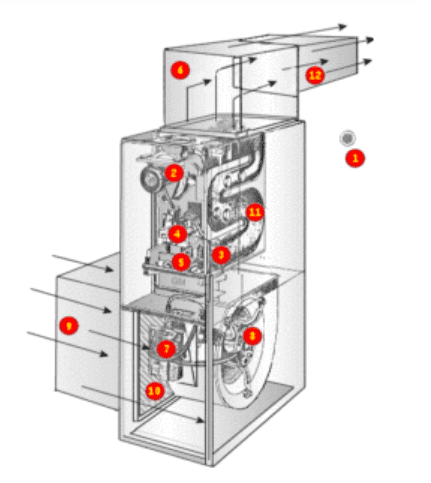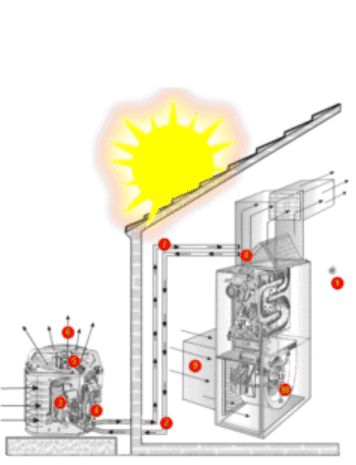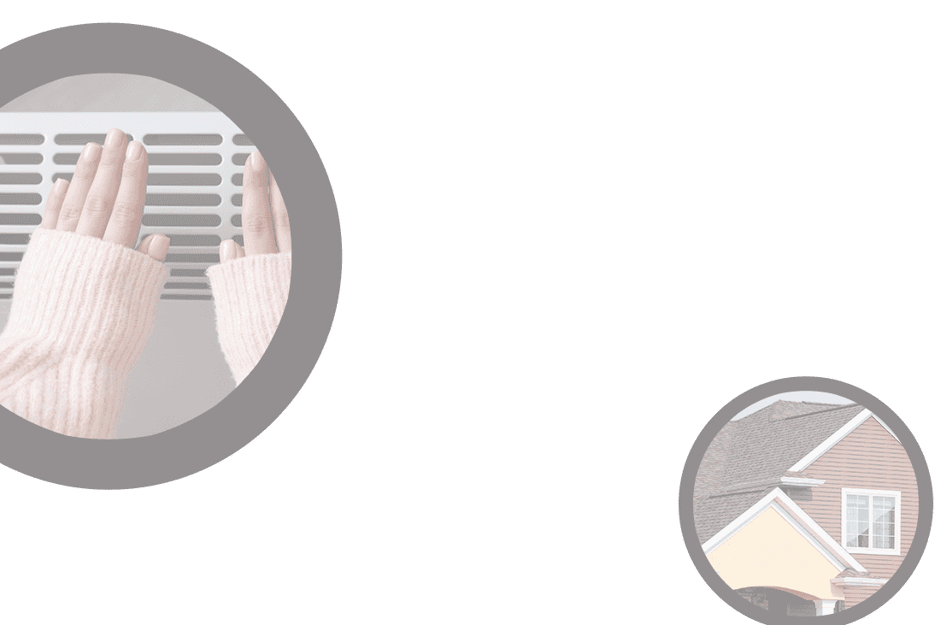
LEARN ABOUT How HVAC Systems Work
-
How it Works
Hire a Trane Comfort Specialist in Virginia Beach
At Climatemakers, we know that choosing a new HVAC system can seem overwhelming. This can be especially difficult without knowing the difference between the many types of systems. Even if you are not planning to replace your equipment but simply wish to understand more about your system’s operation, we can help. Our Virginia Beach HVAC specialists believe in educating our clients and can answer any questions you have about your system.
This includes providing resources on how the following systems work:
- Geothermal energy systems
- Split system heat pumps
- Split system air conditioners
- Warm air heating systems
Understanding What an HVAC System Consists of
HVAC is an acronym which stands for heating, ventilation, and air conditioning. Typically, these systems carry out those functions through a single interface. Many modern systems also include an air cleaning or filtration element in addition to an indoor and outdoor unit. With one thermostat, you are able to control your system without the various components working against each other.
Typically, a boiler or furnace is used for heating, which includes a pipe system or ductwork for forced air systems. Oftentimes, heating systems are connected to residential water systems. This allows the same device to supply warm water and fluid for a radiator. Air conditioning works in the reverse of the heating process, removing heat from inside the house. Ventilation can be natural or forced, depending on the application.
What Is a Heat Pump?
A heat pump is different than most HVAC systems. This unique type of HVAC equipment works in a similar manner to an air conditioner. Heat pumps have the ability to both heat and cool and are often more efficient than other types of HVAC systems. Simply put, heat pumps pull warm air out of the ground or air during the winter to heat your home. During the summer, they work to do the opposite, pulling cool air from the air and using it to cool down your home. The reason they are so efficient is that they are able to move heat from one location to another without using much energy.
Hire Climatemakers for Your HVAC Needs
While this may seem simple enough, a complete, efficient system must be installed and maintained by trained professionals. Our goal at Climatemakers is to help you select a system that will work well for your family in the long run and be optimized to your needs. We serve clients throughout Chesapeake, Norfolk, and the surrounding areas.
-
How Does a Warm Air Heating System Work?
(Gas-fired, up flow model)

Sequence of events:
Thermostat (1) calls for heat and checks all safety devices
(2). Ignitor (3) (or safety pilot) is energized and gas valve (4) opens.
Burner (5) lights.
Heat accumulates in plenum (6), energizes blower control (7).
Blower (8) drawing return air (9) over air filter (10) gains heat from passing over heat exchanger (11) and is distributed thru supply system (12).
When thermostat (1) is satisfied, the sequence is reversed. Gas valve (4) closes; burner (5) shuts off. Air gradually cools and blower control (7) shuts off blower (8).
-
How Does A Split System Air Conditioner Work?

Observation:
Unlike what many people think, an air conditioner does not ADD cool air to an area but instead REMOVES heat from the existing air, leaving the remaining air cooler.
Theory:
Oversimplified, the miracle of cooling is accomplished by the use of (1) refrigerant; (2) a compressor and (3) an evaporator.
Refrigerant acts like a sponge. “Squeeze” (compress) it and the heat is expelled; let it expand and it will absorb heat.
If you squeeze it outside, the heat is expelled into the air; bring it back into the house and let it expand and it will soak up more heat from within.A Visual Sequence Of Events:
Thermostat (1) simultaneously energizes indoor blower (10), outside condenser fan (5), and compressor (3). Refrigerant (2) enters compressor(3) as a low temperature (LT), low pressure (LP) gas. Compressor’s (3) “squeezing” action converts LT/LP gas to high temperature (HT), high pressure (HP) gas as it leaves compressor and enters condenser coil (4). Condenser fan (5) transfers heat from HP/HT gas to the outside air (6); this reduces gas to HP/LT liquid (7). HP/LT liquid (7) leaves condenser coil (4) To Activate This System and enters evaporator coil (8) through a narrow orifice (expansion valve). As liquid expands, it loses pressure reverting back to a LT/LP gas. This LT/LP gas, flowing through the evaporator coil (8), absorbs heat from the return air (9) circulated over the evaporator coil (8) by the indoor blower (10) and returns (2) to the compressor (3) to start a new cycle.
-
How Does A Split System Heat Pump Work?

Observation:
In the cooling cycle, a heat pump is just a conventional air conditioner. For a detailed explanation and a visual sequence of events for a cooling cycle, click here to see our web page “How Does A Split System Air Conditioner Work?”
Theory:
In the heating cycle, the “brain” of a heat pump (the reversing valve) reverses the flow of the refrigerant. Now the refrigerant, instead of extracting heat from within the structure and expelling it outside, extracts heat from the outside and brings it inside.
Heat can be extracted from the outdoor air as long as the temperature of the refrigerant in the outdoor coil is lower than the temperature of the outdoor air. When the outdoor air temperature is 0 degree Fahrenheit it still contains 90% of the heat which it contained at 70 degree Fahrenheit.A Visual Sequence Of Events Of The Heating Cycle Follows:
Thermostat (1st stage)* (1) simultaneously energizes indoor blower (10), outdoor condenser fan (5), and compressor (3). Refrigerant (2) enters compressor (3) as a low temperature (LT), low pressure (LP) gas. Compressor’s (3) “squeezing” action converts LT/LP gas to high temperature (HT), high pressure (HP) gas (7) as it leaves compressor (4) and enters the indoor coil (8). Indoor Blower (10) causes transfer of heat from this HT/HP gas as it circulates return air (9) over the indoor coil (8). As the HT/HP gas loses its heat to the air surrounding the indoor coil, it is reduced to a HP/LT liquid. HP/LT liquid leaves the indoor coil (8) and enters the outdoor coil (4) through a narrow orifice (expansion valve), it literally “boils off” causing it to lose pressure and again becoming a LT/LP gas. This LT/LP gas, flowing through the outdoor coil (4), absorbs heat from the outside air (6) circulated over the outdoor coil by the condenser fan (5) and returns to the compressor (3) to begin a new cycle.
* A heat pump is most efficient at temperatures above 32 degrees (often called the “balancing point”). When the house requires more heat than can be extracted from outside air below the balancing point, electric strip heaters (2nd stage), usually built into the air handler, are energized by the thermostat.
NOTE: Occasionally, heat pumps must remove the frost that forms on the outdoor condenser coil. By going into a “defrost cycle”, heat pumps automatically rid themselves of the frost by switching from heating to cooling for a few minutes to melt this frost. The resulting “steam” that comes from the top of the condenser, accompanied by the sound of the reversing valve, sometimes alarms homeowners unfamiliar with the process.

Exclusive Specials & Coupons

What Makes Climatemakers Stand Out?
-
Pro Dealer of Top-of-the-Line Products Such as Trane and Rinnai
-
Offering Military and Senior Citizen Discounts
-
Background-Checked, Licensed, Insured and NATE-Certified Technicians
-
Locally Grown and Family-Owned Since 1953
-
After Hours Emergency Services Available


Hear from Our Satisfied Customers
-
"I'm a very happy customer!"Drove in a very clean company van and started working after introducing himself. Excellent communication and inspection of HVAC.- Christian S.
-
"They just did a great job! I recommend them unconditionally!"Anthony was great: informative, patient and friendly, but very focused and hardworking through the long day of gas furnace/AC installation.- Patricia S.
-
"Top notch!!"He is a pleasant person who gives a darn about others and does his job with integrity.- Thomas P.
-
"Garry was courteous, professional & efficient."He answered all my questions & provided suggestions on operation of equipment for which I do not have a service contract.- Michael I.
-
"Great service. Problem solved."Technicians were very competent and thorough. I know when Colin is one of them I can feel confident.- Barbara W.
-
"Take care of this man and protect him at all cost!!"Working with Mr. Johnson is always a pleasure. He’s very personable, knowledgeable and kind; I would prefer him be my technician at every visit.- Tiffany R.
-
"Great team and knowledgeable service!"Thank you Gary for getting our home up and running until we could schedule a new system install!- Michael A.
-
"Took time to answer any & all questions."They even went as far as service after the sell by submitting all of the Warranty information for me.- B. Johnson
